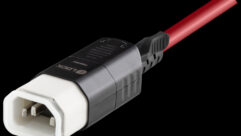Soldering a Phono (or RCA) Connector
1. Trim the cable to the proper length.
2. Slide the outer shell and any strain relief, including heat shrink, onto the cable.
3. Strip the cable jacket approximately one inch to reveal inside conductors.
4. Lay the cable near the connector assembly to assess the length needed for each conductor, and trim conductors to appropriate lengths. The conductors should be cut so that the outer jacket of the cable will be under the strain relief.
5. Strip an appropriate amount of insulation off the center conductor (about 1/16 inch).
6. Insert the cable into the connector with the signal wire landing in the solder point for the center pin. Trim the length of the shield (ground) appropriately to land on the ground connection point.
7. Fold back any remaining black conductor to avoid impeding the connections to be made. The black conductor could be covered by heat shrink and held under the cable strain relief.
8. Remove the cable from the connector and tin the wires that are to be soldered.
9. Tin the connection points on the connector.
10. Insert the cable back into the connector.
11. Solder the red conductor to the center pin soldering point and allow the solder joint to cool.
12. Place the shield conductor to its soldering point. Solder it in place and let cool.
13. If using the heat shrink, slide it up and use a heat gun to seal it.
14. After the connector has cooled, close the crimp ring around the outer jacket and heat shrink if it’s been used. Check soldered conductors; they should have no tension on them.
15. Using a multimeter in the continuity mode: a). Measure between the center pin and the outer shell. Any continuity indicates a short between these two points. If you find a short, do the connection over. b). Measure between a conductor at the unterminated end of the cable and the intended contact point on the connector to ensure proper connection. Do this for each conductor.
16. Slide any insulation, the back shell and strain relief spring (if equipped) over the connection. Make sure that none of the conductors come in contact with the outer shell when it is assembled. When finished, use the meter to test again for a short between shell and center pin.
17. Label the cable appropriately before installation into the system.
Source: “AV Installation Handbook”, InfoComm International.










